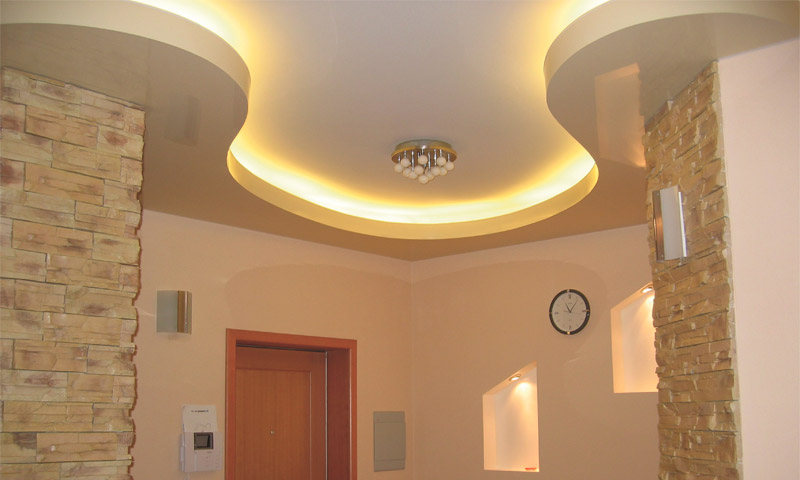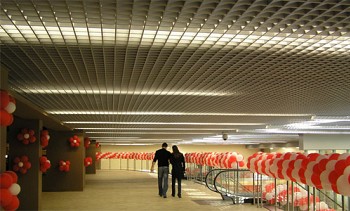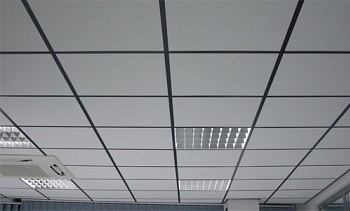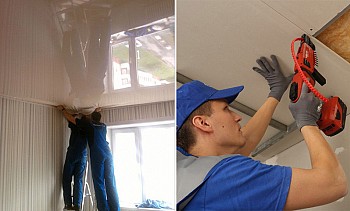Drywall is practical, affordable and aesthetically pleasing. Therefore, structures with cladding from this material are found in almost every modern interior. A variety of options for such finishes allows you to design a room in any style. In particular, there are quite numerous types of gypsum board ceilings, which we will consider in more detail in this material.

Content:
In principle, the type of finished suspended ceiling made of this material is determined by the designer's intention. It can have any fancy form, which, however, is based on one of three types of designs. So, a plasterboard ceiling can be:
- Sibling;
- Simple, having two or three levels;
- Difficult.
Plasterboard single level ceilings
Such a ceiling can be either a ready-made interior element or the basis for a more complex element (multi-level ceiling). The construction of a single-level construction on the shoulder, even to those who do not have much experience. The main thing is to securely fasten the frame made of a metal profile or wood. Mount it close enough to the base. The final stage of the work is the covering of the frame with plasterboard sheets. Before that, lighting is built into the ceiling. And the final touch is the drywall finish.
Important: when mounting the frame, be sure to use the measuring tools. The surface of the ceiling must be strictly horizontal! Do not forget to think carefully about how the electrical wiring and other communications will go.
Advantages of the ceiling in one level:
- The plane of the lined surface does not lose its appearance even if the foundation begins to sag.
- When installing a single-level system, not so much "sneaks" from the height of the room.
- This ceiling helps level the base, allowing you to hide all its flaws and blemishes. In addition, you can mask the wiring and all communications.
- To get rid of excess noise that penetrates you from too active life of neighbors from above, a similar design will also help.

So, if your room does not have a significant ceiling height, then a single-level option will come in handy. You can mask with it everything that is not necessary to notice to an outsider. But the height of the room will hardly decrease. You can decorate the drywall surface to your liking. If you want - plaster and paint, if you want - paste wallpaper.
Two and three-level plasterboard ceilings - more options for imagination
If we talk about ceilings are not too complicated, then their design is built on a general principle. In particular, the basis for them is either concrete ceiling slabs or a single-level plasterboard ceiling. There is one rule: the lower the level, the smaller the area it has. And each next level is mounted (starting from the second, of course) not on the surface of the ceiling, but on the frame of the previous level.
When installing a ceiling of several tiers, it is necessary to calculate the location of individual levels well. They should combine well with each other without creating an impression of disharmony. If the design consists of smoothly curved lines, then you have to use a figured frame and curved gypsum plasterboards. Only experienced installers can do this.
- See more details: How to bend drywall and metal profiles for him.
Important: in a multi-tiered ceiling, the second and third level are designed so that the edge parts of the additional elements look aesthetically pleasing.
Advantages and features of multi-level structures:
- You can "play" with the volume of the room, making it visually larger or smaller.
- Such ceilings make the room very original and give it a touch of personality.
- It is possible with the help of ceiling levels to smoothly separate individual functional zones in the room.
- Complex ceilings, consisting of several tiers, are good only in spacious rooms, the height of which is three meters (or more).
- Each subsequent level "steals" a few centimeters from the height of the room.
- And vice versa - let's say you want to visually enlarge a section of a room. In this case, the zones located in the neighborhood must be omitted using convex elements or boxes.
And now - in more detail about the three varieties of drywall ceilings, consisting of several levels.
Frame ceiling - simple and stylish
Nothing complicated - it's just a box with one or two steps. Sometimes it has not a rectangular, but curly shape. Such a box has a thickness of up to 50 centimeters, located along all the walls of the room. Hidden lights are placed inside its perimeter, and spotlights on LEDs are in the middle of the box. Instead of spot lighting, it is possible to use a chandelier, which is installed in the center of the room.

Diagonal ceiling - very original
The base of this ceiling is flat, but the lower levels are made so that they protrude only above one side of the room. In this case, the dividing line runs diagonally - from corner to corner. It can be either straight or wavy (which is much more interesting). Two parts of the room, located at different levels, can vary significantly in size.

Zone ceiling - convenient for highlighting part of the room
In this case, almost the entire room has the same level. The second or third level defines the boundaries of a functional area (for example, sleeping or working). By area, such zones make up a very small part of the entire room.

Complex types of plasterboard suspended ceilings
In general, they are similar in design to the previous types, only their structure is somewhat more complicated. In particular, any interesting patterns can be used, as well as unusual shapes and elements. For similar designs created by the imagination of designers, it is difficult to strictly classify varieties. However, let’s try to list some of the most popular types of complex drywall ceilings. And we will distinguish between those elements that are used to create them.
Figured ceiling - has a beautiful convex element
Here, against the background of an even base, a figured design stands out - for example, a flower or a complex geometric figure. As a rule, such an element is placed in the center of the ceiling, highlighting it along the edges (along vertical planes). The figure is usually made by the second or third level (and sometimes captures both of them).

Abstract ceiling - for lovers of everything unusual
The most common version of such a ceiling is an irregular spiral design. Other options are possible, as well as an intricate combination of several elements placed along the entire plane. The lighting gives the ceiling a mystery and charm. And if, when painting a surface, take paint of several tones, then you can get a completely unique ceiling. It will look simply stunning.


The soaring ceiling - for those who dream of flying
This type of ceiling is truly extraordinary. Drywall elements are attached to the concrete base in a tricky way. If in more detail, these are fitting sleeves and metal pins with locking studs. The result exceeds all expectations - these fixed figures look as if they are floating in the air. Periodically, you can rotate them on the axis, changing the composition. Naturally, this effect is enhanced by clever lighting.














